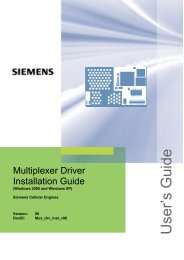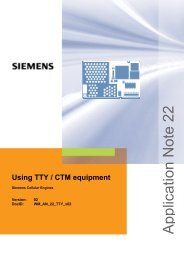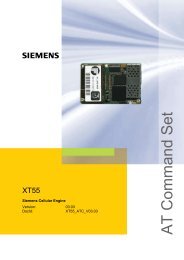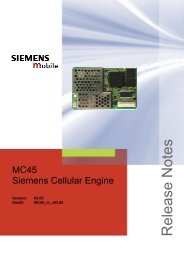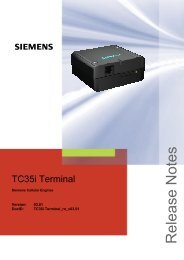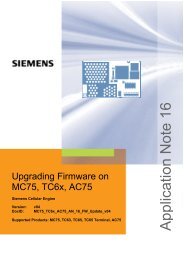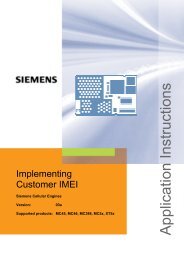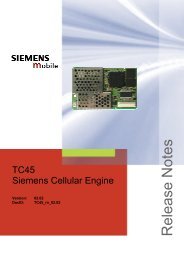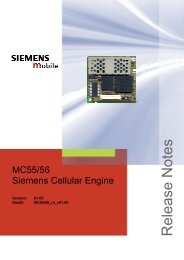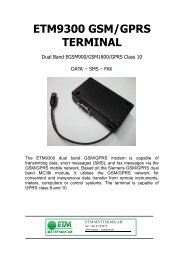Hardware Interface Description - Wireless Data Modules
Hardware Interface Description - Wireless Data Modules
Hardware Interface Description - Wireless Data Modules
You also want an ePaper? Increase the reach of your titles
YUMPU automatically turns print PDFs into web optimized ePapers that Google loves.
MC55/56 <strong>Hardware</strong> <strong>Interface</strong> <strong>Description</strong><br />
Confidential / Released<br />
s<br />
3.5.1 Battery pack characteristics<br />
The charging algorithm has been optimised for a Li-Ion battery pack that meets the<br />
characteristics listed below and in Table 8. It is recommended that the battery pack you want<br />
to integrate into your MC55/56 application is compliant with these specifications. This<br />
ensures reliable operation, proper charging and, particularly, allows you to monitor the<br />
battery capacity using the AT^SBC command (see [1] for details). Failure to comply with<br />
these specifications might cause AT^SBC to deliver incorrect battery capacity values.<br />
• Li-Ion battery pack specified for a maximum charging voltage of 4.2 V and a capacity of<br />
800 mAh. Battery packs with a capacity down to 600 mAh or more than 800 mAh are<br />
allowed, too.<br />
• Since charging and discharging largely depend on the battery temperature, the battery<br />
pack should include an NTC resistor. If the NTC is not inside the battery it must be in<br />
thermal contact with the battery. The NTC resistor must be connected between<br />
BATT_TEMP and GND. Required NTC characteristics are: 10 kΩ +5% @ 25°C, B 25/85 =<br />
3435K +3% (alternatively acceptable: 10 kΩ +2% @ 25°C, B 25/50 = 3370K +3%). Please<br />
note that the NTC is indispensable for proper charging, i.e. the charging process will not<br />
start if no NTC is present.<br />
• Ensure that the pack incorporates a protection circuit capable of detecting overvoltage<br />
(protection against overcharging), undervoltage (protection against deep discharging)<br />
and overcurrent. The circuit must be insensitive to pulsed current.<br />
• On the MC55/56 module, a built-in measuring circuit constantly monitors the supply<br />
voltage. In the event of undervoltage, it causes MC55/56 to power down. Undervoltage<br />
thresholds are specific to the battery pack and must be evaluated for the intended model.<br />
When you evaluate undervoltage thresholds, consider both the current consumption of<br />
MC55/56 and of the application circuit.<br />
• The internal resistance of the battery and the protection should be as low as possible. It<br />
is recommended not to exceed 150mΩ, even in extreme conditions at low temperature.<br />
The battery cell must be insensitive to rupture, fire and gassing under extreme conditions<br />
of temperature and charging (voltage, current).<br />
• The battery pack must be protected from reverse pole connection. For example, the<br />
casing should be designed to prevent the user from mounting the battery in reverse<br />
orientation.<br />
• The battery pack must be approved to satisfy the requirements of CE conformity.<br />
Figure 8 shows the circuit diagram of a typical<br />
battery pack design that includes the protection<br />
elements described above.<br />
to BATT+<br />
to BATT_TEMP<br />
ϑ<br />
to GND<br />
NTC<br />
Protection Circuit<br />
+ -<br />
Figure 8: Battery pack circuit diagram<br />
Battery cell<br />
Polyfuse<br />
MC55/56_hd_v02.06 Page 39 of 105 29.10.2004



